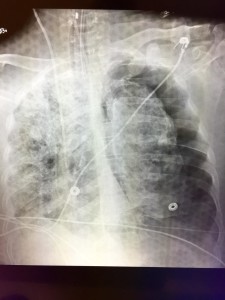I was called to a code in the ICU. I roll into the room, 38yo IVDA hx, admitted for sepsis, septic emboli, and ARDS. Stable vital signs 10 minutes previously, now in PEA arrest. Already tubed and had a triple lumen in the IJ. Not a whole lot for me to add for immediate stabilization with a secure airway and access. Already had epi x1. Accucheck was 149 (never, never forget this in a code).
So I immediately get to go to the second phase and start thinking reversible causes. With that hx, all sorts of interesting diagnoses on the playing field. The one major thing I notice was the patient was extremely cyanotic from the upper chest on up. CBC and BMP from a few hours ago essentially unremarkable aside from a white count of 26. Coags normal. Actually starting to kick around the idea of empirically thrombolyzing this dude. All of a sudden, quick run of v-fib, zap him with 200 and voila! we have a pulse. I order a new rainbow of labs, cxr, call his pulmonologist to recite my efforts, and strut back down stairs with a little gangster lean feeling pretty good.
I sit down, take a deep breath, and head to see the next patient. And BOOM! Code alarm goes off once again. Head back into the room, next verse same as the first. Guy suddenly went PEA arrest again, CPR was already in progress. No labs back. I have them pull up the CXR.
Well sh*t, I swear I listened to him during the first code. Bilateral breath sounds (course, but there). I listen again, knowing there is a big pneumo, still can hear. Obvious tracheal deviation on the CXR, but time to get moving. So I ask for an angiocath and a chest tube set up. Deer in headlights, no one moves. Someone finally scurries off to find a pleurovac and tube.
Still waiting for an angiocath, they hand me something that looks like something I’d LP a 10 day old with, not gonna cut it. Finally they roll in with this kit that looked like they pulled off a dusty shelf. Has what looks like a 8 inch spinal needle with a pigail catheter already attached to it. That’s it. nothing else in the kit besides and adaptor to attach to the pleuravac. Don’t have a lot of time to search for anything else so I went with it. Was actually really slick- put the needle into the chest cavity, pulled out the inner cannula, heard the hiss and fed the pigtail. That’s it, working chest tube in place in about the same time it would take to do a needle decompression.
Immediate return of pulse and stable blood pressure. Thank god. That would have been a totally reversible cause of death in a young patient. If I hadn’t ordered or remembered to check that x-ray, would have been on my shoulders.
I post this for a couple of reasons.
#1 Don’t get too cute in your codes. Start with the basics and build from there. I was too busy thinking about lytics etc, and had an easily reversible cause right in front of me. Don’t forget your DOPES mnemonic for ventilated patients.
D- dislodgement, check your tubes, end tidal or even preferably direct visualization. Especially in a patient getting CPR.
O- obstruction, always suction, mucous plugging is an easy removal.
P- Pneumo, already talked this through.
E- Equipment, I recommend always pulling your codes off the vent and bagging through the ET tube to take this one off the radar.
S- stacked breaths. Too much PEEP or high respiratory rates without adequate expiration time can cause air trapping and decreased venous return. Once you pull someone off the vent and bag. Take a second and manually press the chest wall down. Can fix the problem immediately and you look like a total ninja if it works.
![Room9er ["Room Niner"]:](https://room9er.com/wp-content/uploads/2020/03/cropped-Screen-Shot-2020-03-08-at-3.16.16-PM.png)

